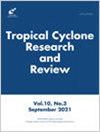Rapid intensification of the Super Cyclone Amphan: Environmental drivers and its future projections
IF 4.1
4区 地球科学
Q3 METEOROLOGY & ATMOSPHERIC SCIENCES
引用次数: 0
Abstract
Tropical cyclones are intense weather systems that originate over warm tropical oceans and they alter the dynamical, chemical, and biological state of the oceans. Here, the reasons for the rapid intensification of Super cyclone Amphan that occurred in May 2020 in the Bay of Bengal (BoB) are thoroughly investigated. One of the main causes for the intensification of Amphan into a super cyclone is the rise in sea surface temperature (SST). Additionally, the warm-core eddies present in the track of cyclones also contributed to its rapid intensification. The Tropical Cyclone Heat Potential (TCHP) and Upper Ocean Heat Content (OHC) were consistent and remained high throughout the cyclone period to maintain its high intensity. Although there were greater cyclone-induced cold wakes during the period, the background SST conditions were still higher and were favourable for the cyclone to intensify further. The vertical wind shear in both shallow and deep layers was minimal, which further helped the formation of a stable and strong cyclonic vortex, and thus contributed to its rapid intensification. The behaviour of cyclone Amphan in future scenarios is analysed using a coupled atmosphere-ocean model. Compared to the current scenario, the severity of cyclones is expected to increase in the future (RCP 8.5). Early landfall is observed in the case of RCP 4.5. As a result of elevated UOHC, Amphan attains more strength in the RCP 8.5 than it does in the present scenario. The translational speed increases in the future, which makes the cyclone move faster. Due to the passage of Amphan, there is a reduction in UOHC, which is higher in the case of a future warm climate. This suggests that additional energy from the ocean is transferred to the atmosphere, causing the cyclone to intensify further. According to the results from the coupled atmosphere-ocean model, the future warm atmospheric and oceanic conditions will be more favourable for the genesis and development of stronger cyclones.
超级气旋安潘的快速强化:环境驱动因素及其未来预测
热带气旋是起源于温暖的热带海洋的强烈天气系统,它们改变了海洋的动力、化学和生物状态。本文对2020年5月发生在孟加拉湾(BoB)的超级气旋安潘(Amphan)快速增强的原因进行了深入研究。海温升高是安番增强为超级气旋的主要原因之一。此外,气旋路径上存在的暖核涡流也有助于其快速增强。热带气旋热势(TCHP)和上层海洋热含量(OHC)保持一致,并在整个气旋期间保持高强度。在此期间,虽然气旋诱发的冷尾较强,但背景海温条件仍然较高,有利于气旋进一步加强。浅层和深层的垂直风切变都很小,这进一步促进了稳定强气旋涡的形成,从而促进了气旋涡的快速增强。利用大气-海洋耦合模式分析了气旋安潘在未来情景中的行为。与目前的情景相比,预计未来气旋的严重程度将增加(RCP 8.5)。在RCP 4.5的情况下,观察到提前登陆。由于UOHC升高,Amphan在RCP 8.5中的强度高于目前情景。未来平动速度增大,使气旋移动速度加快。由于Amphan的通过,UOHC减少,在未来气候变暖的情况下,UOHC会更高。这表明来自海洋的额外能量被转移到大气中,导致气旋进一步加强。根据大气-海洋耦合模式的结果,未来温暖的大气和海洋条件将更有利于强气旋的发生和发展。
本文章由计算机程序翻译,如有差异,请以英文原文为准。
求助全文
约1分钟内获得全文
求助全文
来源期刊

Tropical Cyclone Research and Review
METEOROLOGY & ATMOSPHERIC SCIENCES-
CiteScore
4.60
自引率
3.40%
发文量
184
审稿时长
30 weeks
期刊介绍:
Tropical Cyclone Research and Review is an international journal focusing on tropical cyclone monitoring, forecasting, and research as well as associated hydrological effects and disaster risk reduction. This journal is edited and published by the ESCAP/WMO Typhoon Committee (TC) and the Shanghai Typhoon Institute of the China Meteorology Administration (STI/CMA). Contributions from all tropical cyclone basins are welcome.
Scope of the journal includes:
• Reviews of tropical cyclones exhibiting unusual characteristics or behavior or resulting in disastrous impacts on Typhoon Committee Members and other regional WMO bodies
• Advances in applied and basic tropical cyclone research or technology to improve tropical cyclone forecasts and warnings
• Basic theoretical studies of tropical cyclones
• Event reports, compelling images, and topic review reports of tropical cyclones
• Impacts, risk assessments, and risk management techniques related to tropical cyclones
 求助内容:
求助内容: 应助结果提醒方式:
应助结果提醒方式:


